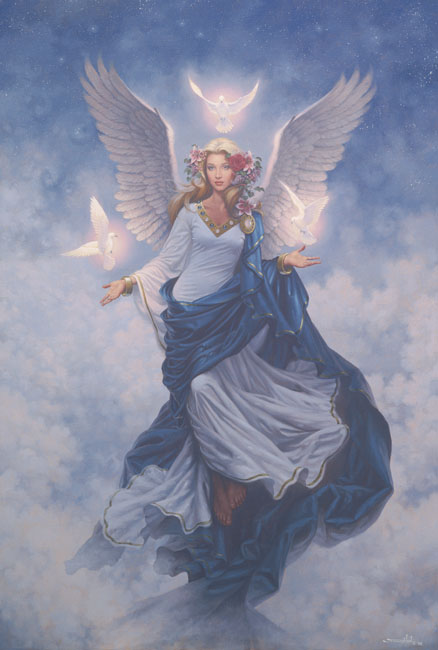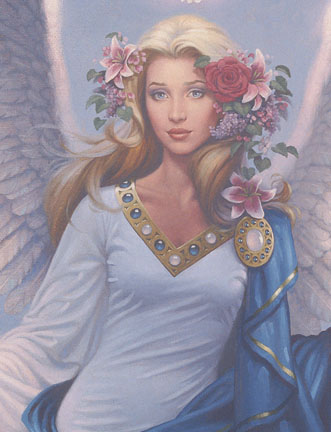In
these dream-world and real-world examples of the trinity, in these
reckonings of the dimensional totality of things, there is an implicit, unspoken
question: this abundant three-fold
cosmos - where did it all come from? Whence the gods of space-time, great and small? Interestingly, the motif of the Trinity
actually seeks to address this question ‑ and in a very quiet
way...
Resurrection of the Moon
After
noticing the sun up in the sky, humanity’s first celestial reckonings were of
the moon ‑ that life-sustaining beacon of light in the predator‑filled
darkness. Archeological evidence
indicates that worship of the moon dates back at least 25,000 years. And if we can read anything into the
nocturnal activities of coyotes and wolves (and many other animals), our
response to Luna (from which we get the word “lunacy”) may be far older and
even more primal than we imagine.
There
are three visible phases of the moon: first quarter, full moon, and last
quarter. But of course there is another phase of the moon, the new moon ‑
the unseen forth. The moon comes
into being, achieves full being, goes out of being, and hides in non‑being
for three days before it emerges once more into the starry sky. And as the moon regenerates in, and
resurrects anew from, an unknown place of eternal mystery, so too does Life:
within the Domain of the Goddess.
It
may be useful to pause for a moment here and reflect upon these ancient
reckonings of things, made by ancient people. It is easy for us to suppose that
we are very far removed indeed from those wretched creatures. We now live in our comfortable Tower of
Babel, well insulated from the rigors of nature. We are warm in the winter,
made well when we are sick, entertained in the comfort of our own home, and
able to communicate in an instant across spectacular distances. Surely we are above the primitive savages
who howled at the stone‑age moon?
Homo‑sapiens
‑ man the wise ‑ first emerged as a distinct species about
100,000 years ago (or more, according to some sources). If the entire biological history of our
species were a journey of one mile, then the 5000-year span of written history
would be a distance of only 80 yards.
And the span of what has really elevated us above the sufferings of our
ancestors ‑ our technological history ‑ is a mere eight feet; eight
feet of ease at the end of 5280 feet of misery. In the 5000 generations of Man (20 yrs/generation X 5000
generations = 100,000 yrs), some 4994 of those have been lived bereft of the
opiate embrace of technology. I think
it is clear that 4994 iterations of natural selection have shaped the
architecture of the human psyche to a significantly greater extent than the
last six. We are genetically equivalent
to the pitiful beasts who attacked wooly mammoths with stones and sticks ‑
with an equivalent capacity for kindness or brutality, wisdom or ignorance.
Of
course we now know that the moon does not venture off to some other universe to
be reborn, but our capacity for awe in the face of The Unknown
remains. What troubled us for those
many tens of thousands of years, in some mysterious way, troubles us still...
The Unseen Goddess
In
all the examples of the trinity listed above there is an unseen forth, which
represents the Mysterium Tremendum ‑ the Infinite Unknown that is
the dimensions of existence beyond the knowable universe. In Hinduism, She is Devi ‑ the Source
of all the Gods. In Greece, She is Gaia
‑ the Body of the Earth (and in some traditions, the Cosmos itself). In Buddhism, She is Maya ‑ the Veil
that is our thoughts and perceptions of the world. In time, She is Eternity ‑ the timelessness from which time
grows. In Space, She is hyperspace ‑
a transcendent spatial existence inside of which our universe resides, and into
which gravity inexorably beckons all things...
And
so I have endeavored in this image of the Unseen Forth to give a face to The
Mystery, and there are several unseen forths in this image. There is a trinity of lilies, with a single
red rose. There is a trinity of small
diamonds in Her sapphire necklace, with a larger diamond in the center of her
twelve-sapphire brooch. And of course
there is the trinity of doves, fluttering around the angelic apparition in the
center: Mary ‑ Mother of God.
The Miraculous Conception of
the Redeemer
Perhaps
the most significant feature of this mythology is Mary’s supernatural purity ‑
Her virginity. This motif of the
Miraculous Conception is also found in all times and regions of the world. In
the Hindu tradition (dating back some 3500 years), Devaki is the Virgin Mother
of Krishna ‑ the human incarnation of Vishnu, the Preserver of the
Universe. In the Buddhist tradition
(dating back some 2500 years), Queen Maya is the Virgin Mother of Gautama
Buddha ‑ the living incarnation of all‑knowing Buddha
Consciousness. In the Arthurian
tradition the Sage‑prophet Merlin is conceived of a Virgin Mother and a
“golden being of light”. (Chretien de Troyes’ seminal masterwork ‑ Li
Contes del Graal, c. 12th Century ‑ is a Christian interpretation of
far older Celtic stories that may date back 2500 years or more.) There are many such examples of the virgin
birth in the sacred books of the world, including a story at least 5000
years old:
Heaven
and Earth adored each other from across the great distance between them,
longing for the day when they might be together. Ra ‑ He who had
fashioned the cosmos with His own hands ‑ lived in terror of their
longing, for prophecy foretold the union of Celestial Spirit and Terrestrial
Matter: from their love must come beings even greater than Ra. Despite His efforts to keep them apart, Nut,
Goddess of the Heavens, and Geb, God of the Earth, found each other for a
single, eternal night. When Ra returned
from His nightly sojourn of regeneration in the Underworld, He found them
together and an inconsolable rage came upon Him. He cast the lovers apart until the end of time, but His fury was
in vain, for the prophecy was true: Nut gave birth to Four new Divinities, and
they were indeed far greater than Ra.
Brothers Osiris and Set, and Sisters Isis and Nephthys became the new
regents of the cosmos; it was they who brought Life to the endless emptiness of
Ra’s creation.
Nature
is a double‑edged sword. It is the golden luminance of dawn, seen through
incandescent lotus blossoms on the Nile.
And simultaneously, it is the ravenous lion raking the living flesh from
a screaming antelope. And so, where
Osirus sought to bring life into the world, Set wished only to drag it back
into the earth. Where Osiris dreamed of what might one day become of the
children basking in His gentle light, Set schemed in darkness to keep them
savages. Such animosity could not long
endure, and at a gathering of the Gods one night, Set murdered His
Brother. He hacked Osiris’ body into 72
pieces, and scattered them to the ends of the earth. And then He sat back upon His throne - the new demon-king of the
fearful gods.
(In
this divide between Set and Osiris, we see something of the ideological dichotomy
that endures to this day: the Way of Strength or the Way of Compassion.
Pragmatism or Idealism. Are we to accept the world as it is, or are we
to make the world as it should be?
It is ever the human quest to find a balance between the two.)
Set
had miscalculated, however, and it would prove to be His undoing: He had not
expected the extraordinary devotion of Osiris’ Wife. Isis, Goddess of the Elements, was overcome by sorrow. She left behind Her sacred task as Goddess
of Life so that She might search for and find those 72 pieces of Her beloved
Husband. And as She searched those many
years, Set’s dark putrefaction slowly crept over the earth. After a long series of adventures, Isis
finally ventured to the dismal Underworld ‑ the Land of the Dead ‑
passing through the seven Gates of Hell to find the 71st and last extant piece
of Osiris. His corpse was now complete
but for one irretrievably lost component: His reproductive member.
Even
the Goddess of Life requires a seed to make life, and so Isis lay down beside
the lifeless Osiris, content to dwell for eternity in the Underworld with the
empty husk of Her Beloved. But in that
moment a wonderful metaphysical union occurred, as the wandering spirit
of Osiris found Isis and entered into Her womb. In that transcendent
conjunction of The Ethereal and The Material, a new and miraculous force
entered into the universe. He was soon
brought forth into the living world again as Horus: Father resurrected as the
Son, the Eternal Life-Force of Egypt to whom all the Pharaohs were but
garments. And by his eventual victory
over the chthonic, life‑negating will of Set, Osirus‑Horus became
the Redeemer of World...
We
cannot fail to notice here an unmistakable similarity to a story with which
everyone in the western world is familiar. It is apparent that the soul‑nourishing
waters of these many different stories have been drawn from the same
ancient Well of Sacredness...
Spiritual Beings
What
is this mythology of the Virgin Birth? For some, this is emphatically not
mythology but history: the Virgin Birth is a journalistic account of
events that actually happened in space and time ‑ just like The Book
said. If this is true, then the
prevalence of this story in many sacred books from all over the world suggests
that there is a significant amount of this metaphysical coupling going on, and
the Creator of the universe is every bit as libidinous as the ancient Greeks
imagined Zeus to be. Could there be another
explanation for the universal distribution of the Myth of the Miraculous
Conception?
To
realize the awesome magic and beauty of the universe, and love the infinite
mystery and potential manifest in all things is to transcend the
changeless destiny nature granted us at birth.
For most of us, when we walk the Eternal Dreamscape, drink from the Holy
Grail, and touch the Noumenal Truth that dwells in the heart of the Unknown
Continent of the human psyche, we awaken as though we are leaving a theatre
where the make‑believe world is left behind. But there are a privileged few who get their treasure past the
dragon who guards the gates, and return to the land of consciousness still
aware of ‑ still communicating with ‑ that primordial Will
that generates the Eternal Dreamworld.
We
come into this world by virtue of a physical act of union, and are born
physical beings, slaves to the many contradictory instincts we require for
survival. By a metaphysical act
of union with the genesis of all thought we achieve a kind of rebirth, a
spiritual coming into being. To
achieve a Virgin Birth is to enter into a world of more than mere
nature, a magical domain of new and extraordinary possibilities where our
destiny is truly ours to determine.
And we shall see that free will is a magic great beyond all
compare...
|

